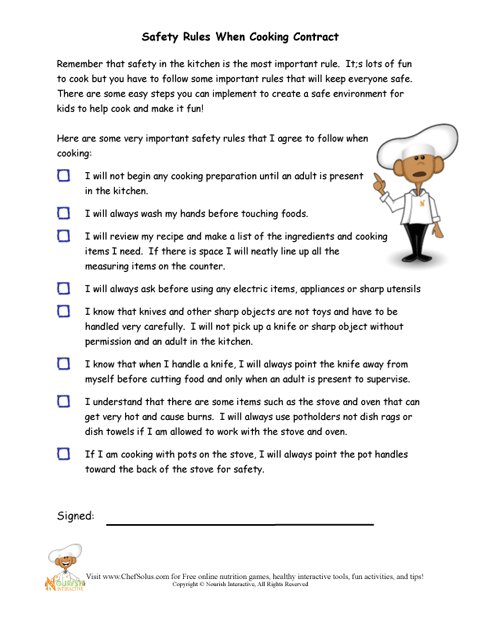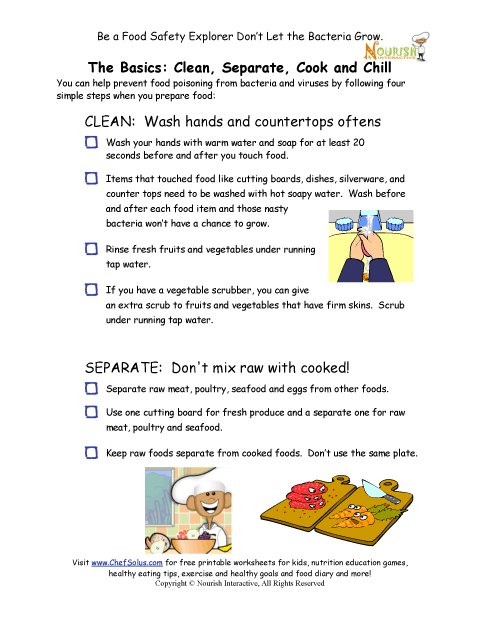Week 1:
Cooking Safety Rules (
Contract)
Food Safety in the Kitchen (Clean, Separate, Cook & Chill)
Recipe:
Muddy Buddies
Week 2:
Cooking Vocabulary Words
Week 3:
Cooking Utensils
Cooking Appliances
Week 4:
Five Food Groups Learning Sheet
Week 2: Review Kitchen Safety Rules. Practice Spreading—Make
Apple Frogs or Spiders
Week 3: Practice Peeling- Make
egg boats, allowing child to peel the hard-boiled eggs. Or allow child to peel a banana. Review spreading—make a peanut butter & banana sandwich.
Week 4: Practice tearing & tossing- Make a
green salad
Week 5: Practice Cutting & “My Favorite Fruits”-- Go to the grocery store together & pick out 5 or 6 types of fruits (some new, some favorites). Go home & make a fruit salad. Allow child to practice cutting some of the fruits using a butter knife. Complete the “
My Favorite Fruits” portion of the lapbook using
clipart of fruit. Allow the child to pick his/ her 5 favorite fruits from the pictures.
Week 6: “My Favorite Vegetables”—At the store, have child pick out several types of vegetables in order to make
vegetable soup (some favorites, some new). Allow child to help cut the vegetables & mix the soup. Complete the “
My Favorite Vegetables” portion of the lapbook using clipart.
Week 7: Learn about the Food Pyramid—Print out
this copy for child to look at. Use a grocery store flyer or magazines to cut out pictures of food. Make a Food Pyramid on a large piece of paper and have child sort the pictures into the correct categories. Optional: Use my
Five Food Groups Workbook for extra practice.
Week 8: Go to the grocery store for a special “tour.” Point out the layout of the foods, placing emphasis on the food groups. Use the store flyer to make a “Scavenger Hunt”—several items for the child to find and check off as you walk through. Point out unhealthy food choices.
Week 9: Learn about
kitchen equipment. Put in plain sight all your kitchen appliances, pots, pans, cooking utensils, etc. Give child small cards with the names of each item on them. (Or if he is a writer, allow him to write himself.) Go on a scavenger hunt to label each item with the cards. Add the Kitchen Equipment page to your lapbook.
Week 10: Practice measuring. You could make any easy recipe for this. Make your favorite cookies or brownies. Allow child to use different measuring cups & spoons to follow the recipe and add the ingredients. You could also use this as a math lesson. Show how many teaspoons are in a Tablespoon or what 1/2 of a cup looks like.
Week 11: Practice rolling. Make
Crescent Pepperoni Roll-Ups or these
Chicken Roll-Ups, allowing child to roll the crescents.
Week 12: Have fun being creative! Make
Bagel People or Fruit Kabob Creatures. Make a non-food recipe, like
Play-Doh.
Week 13: Make a balanced meal together. Make it a big celebration of learning how to cook. Invite friends! Allow child to help as much as possible. Have her choose dishes she would like to eat, reminding her about the Food Groups and choosing from each. Find recipes for each dish and have child help you make a shopping list and then buy the necessary items. Make sure you also allow child to set the table properly and use the occasion to teach about
Table Manners & Etiquette.
Download an
Assistant Chef Cooking Certificate here!



